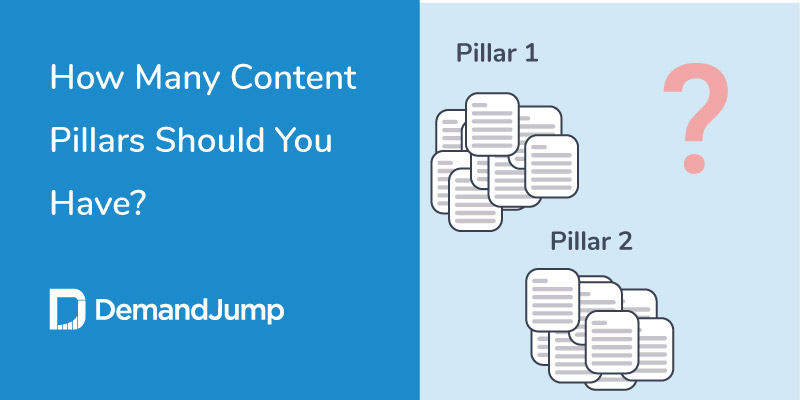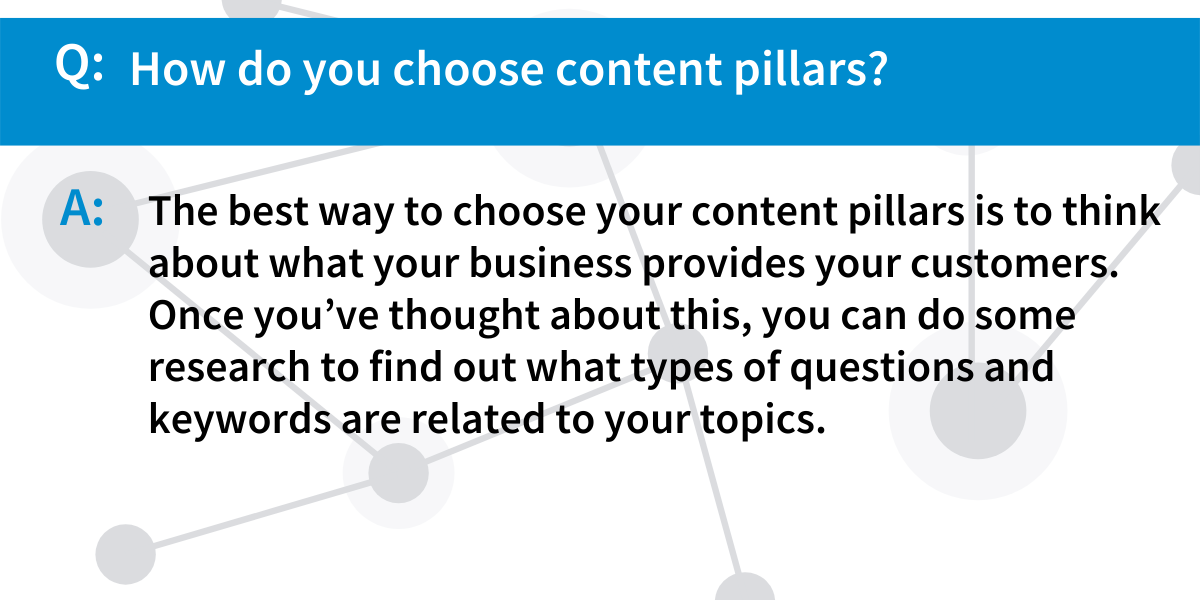How Many Content Pillars Should You Have?
June 14, 2021 •DJ Team

An SEO pillar strategy is the best way to win at content marketing in 2021. Content pillars are a novel type of content strategy framework that involves the creation and tactical interlinking of related pieces of content. This type of content strategy framework allows your business to harness its industry knowledge and share what they know with the world, and in turn, increase website search engine rankings.
What are content pillars?
There are three types of pillar pages and related content: the main pillar, sub-pillars, and supporting blogs. The main pillar should be titled the general, short-tail keyword you’re covering as a topic and should be an ultimate guide that is over 3,000 words. The sub-pillars should be titled slightly longer-tail keywords that dive deeper into subjects talked about in the main pillar. These should be about 2,000-2,500 words. Supporting both the main pillar and sub-pillars are a series of blogs that have titles in the form of long-tail, commonly-asked questions about a subtopic. These blogs should be about 750 words.
The format of a content pillar strategy can be fairly straightforward, but the more difficult question is “How many content pillars should you have?” Let’s dive into this question to see how many pillars you should have and what those pillar pages should look like.
How many content pillars should you have?
On a high level, you should have a pillar for every major topic you want to rank for. If your company sells four different types of products, a pillar should be created around each one and encompass the key topics that your brand revolves around. The same is true if you’re selling to different audiences and each product or audience has a distinctive set of terminology.
How do you choose content pillars?
The best way to choose your content pillars is to think about what your business provides your customers. What is your expertise? What services do you provide or products do you sell? Once you’ve thought about this, you can do some research to find out what types of questions and keywords are related to your topics. With DemandJump, that process is a snap! You can see what people are searching for around a particular topic, as well as search volume, to help you understand which topics are best to write about.

What does this look like in practice? Let’s imagine a company that provides both outsourced accounting and human resources (HR) services. They want to rank high on search engines for accounting and HR. They could create two content pillars, one focusing on HR and the other accounting, with sub-pillars and supporting blogs that dive deeper into the individual topics and explore the related questions their audience is asking. With DemandJump, they can see that outsourced accounting has slightly higher search volume, so they will prioritize that pillar first.
How many pillar pages should you have?
For each main pillar, there should be a series of at least three sub-pillars plus three supporting blogs and no less than three supporting blogs per sub-pillar. This means each pillar is supported by at least 16 pieces of shorter content.
Depending on how wide a topic ranges, there could be even more sub-pillars and blogs. The sub-pillar pages target the keywords that are the most relevant and have the most competitive landscape, which in turn drives the most traffic to websites.
Once you have created the list of content pillars you’d like to address, you can start researching topics and questions for the sub-pillars and blogs. To find sub-pillar topics, search for your short-tail topic in a search engine. At the bottom of the search page, the slightly longer-tail, “related search terms” listed are likely the most frequently searched subjects for the topic. These are the key, high-traffic keywords that can be used for your sub-pillar topics. To dive deeper into creating blog post topics, look up these longer keywords in turn and use the questions you find as the topic for each blog.
List of content pillars example
An example of this method could be seen in a life insurance company’s pillar approach to drive more traffic to their website. The company’s main pillar could be an ultimate guide covering the short tail topic: life insurance. They could then break down the topic into sub-pillars using specific, relevant keywords. These might look like:
- Types of life insurance
- Life insurance rates
- Best life insurance
From there, they would review specific, commonly asked questions for supporting blogs for each sub-pillar. For “types of life insurance” blogs could look like:
- How do I choose the right life insurance for me?
- How much life insurance should I consider?
- What should I know before getting life insurance?
How many links should a pillar page have?
The number of internal links depends on how many sub-pillars and blog posts are in your content strategy plan. There are a few rules to interlinking posts within this strategy. The content pillar strategy is great alone, but the way each piece of content is linked to each other is where the magic happens. When done correctly, interlinking posts can send the search engine signals that indicate deep, rich content surrounding a topic.
Here are the main rules for interlinking pillar posts:
- The main pillar should have no internal links. A pillar is the ultimate authority of the topic at hand and should not link to a sub-pillar or a blog post.
- The only internal links sub-pillars should have is to the main pillar.
- The only internal links in a supporting blog post should be to the sub-pillar and the main pillar.
- It’s okay to link to external sources in pillars, sub-pillars, and blogs, but those external links should be limited only to authoritative sources--never competitors.

DemandJump can help you with your next content pillar
Creating a content pillar strategy can be challenging, but the rewards harvested from a successful strategy are numerous. As long as the basic format is followed and you know exactly what your target audiences are searching for surrounding the topic you’ve chosen, you can build effective content pillars that outrank the competition and drive significant traffic to your brand’s website.
The key to success is knowing precisely what your audience is looking for. That is where DemandJump comes in. We can help you with both strategy and execution. All you need to do is type in your topic of interest. With our powerful content insights tools, you can run a report that prioritizes the exact pieces of content you will need to create for sub-pillars and supporting blogs.
To make things even easier, the platform generates SEO-optimized content outlines to save you innumerable hours of content prep. Try it for free and see just how easy creating and acting on your content strategy can be.
Featured Articles
Categories
- Attribution Tracking (13)
- Channel Optimization (11)
- Consumer Insights (68)
- Content Marketing (251)
- Data Science (8)
- Digital Marketing (6)
- Digital Transformation (26)
- Enterprise (10)
- Lead Generation (14)
- Market Intelligence (8)
- Marketing Analytics (39)
- Marketing Attribution (57)
- Marketing Management (153)
- Marketing Operations (86)
- Organic Search (222)
- Paid Search (52)
- Pillar-Based Marketing (63)
- Programmatic Advertising (9)
- SaaS Content (14)
- SaaS Marketing (29)
- Search Marketing (111)
- SEO Keyword Research (28)
- SEO Pillar (18)
- SEO Strategy (46)
- SMB (5)
- Website Content (12)


